Diving Iron Bottom Sound
The World War II Wrecks of Guadalcanal
copyright © 2007 Bradley Sheard
This article was originally published in Issue 12 of Wreck Diving Magazine.
wreck diving magazine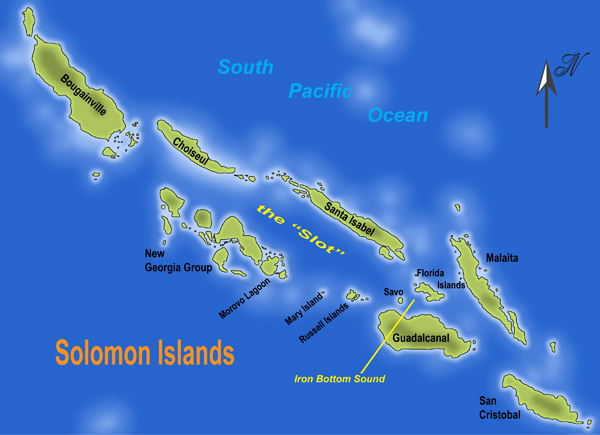 |
Three "Val" dive-bombers broke out of heavy clouds over Florida Island, unseen and unheard, and descended straight for the USS Aaron Ward from out of the sun. Her gunners, already occupied tracking an aerial dogfight over Tulagi, didn�t see the carrier-based bombers until they were nearly upon her. As her attackers bore down upon the nimble destroyer, she whipped around in a hard left turn, bringing her guns to bear and opening fire--but it was too late to fend off the attack. Explosions rocked the destroyer as near misses tore holes in the side of her hull; a direct hit in the engine room cut power to the gun mounts and steering gear. The gunners continued to fire at their attackers under local control, while the ship continued in an uncontrolled left turn, her rudder disabled. Three more bombers roared down on the paralyzed destroyer, dropping their deadly projectiles close along her port side.
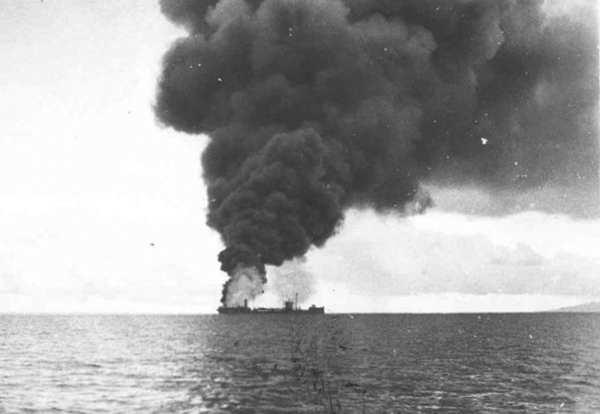 |
| The tanker Kanawha burning after Japanese aerial attack |
Not far from the Ward, inside the confines of Tulagi harbor, a furious battle was taking place between the Japanese assailants and a host of Allied shipping. Present at Tulagi before the attack were an assortment of torpedo boats, three tugs, several transports and LSTs, the veteran tanker Kanawha, the New Zealand corvette Moa and a handful of other small craft. There had been warning of the coming aerial assault by coastwatchers in Bougainville, and some of the ships had gotten underway before their arrival, including the ancient Kanawha. This was the second global conflict the Kanawha had seen--she was built in 1913, had seen duty during the Great War and served in both the Atlantic and Pacific theaters since. Kanawha had gotten underway to join her escort, the destroyer USS Taylor, just outside of the harbor when eighteen enemy planes descended toward Tulagi; fifteen made for the juicy old naval tanker. Five of the attackers unloaded their ordinance on the Kanawha, lighting numerous fires and destroying the engine room. Her skipper ordered the crew to abandon ship while the remaining ten planes redirected their attack to other prey, convinced the Kanawha was mortally wounded. Taken under tow and beached off Tulagi, the tanker slid off the reef into deep water before the sun rose the following day.
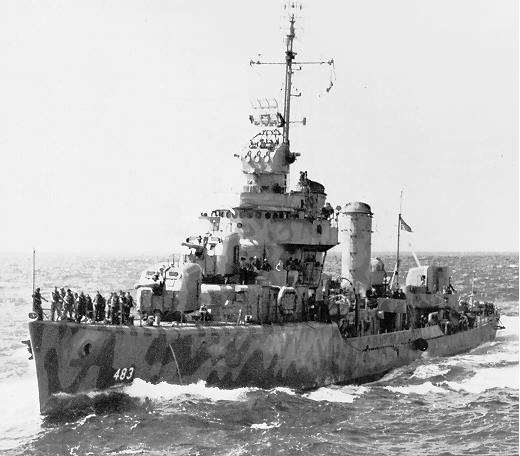 |
| The USS Aaron Ward during the war. |
Not all of the ships in the harbor got word of the impending attack. One that did not was the small corvette Moa, which was still taking on fuel from the tanker Irskine Phelps when the Japanese planes dropped out of the sky. Two bombs, probably intended for the tanker that was feeding her, slammed into the corvette and sent her to the bottom of the harbor in only four minutes.
The aerial attack over, her engine and fire rooms flooding, Aaron Ward, survivor of the tremendous "Naval Battle of Guadalcanal" six months earlier, was in serious trouble once again. Two tugs, Ortolan and Vireo, which had been huddling under the Ward�s antiaircraft umbrella during the attack, now took her under tow toward Tinete Point near Tulagi in an attempt to beach her. But the Aaron Ward�s combat days were over, and only 600 yards short of shoal water she settled stern first into the depths of Iron Bottom Sound.
The attack, part to Admiral Yamamoto�s "I" Operation, sent a destroyer, a corvette and a veteran tanker to the bottom and damaged two other ships. Intended as a massive aerial assault to wipe out one or more of the bases the Japanese had recently lost to the Allies in the Solomon Islands, the attack was composed of 67 "Val" dive bombers and 110 Zero fighters; they were met by 76 assorted fighters of the Cactus Air force based on Guadalcanal. Aerial reconnaissance during the prior week had noticed a buildup of Japanese aircraft in the upper Solomons, giving the Allies advance warning that something was up--on April 7, 1942, that something turned out to be the largest Japanese aerial assault since Pearl Harbor.
*******
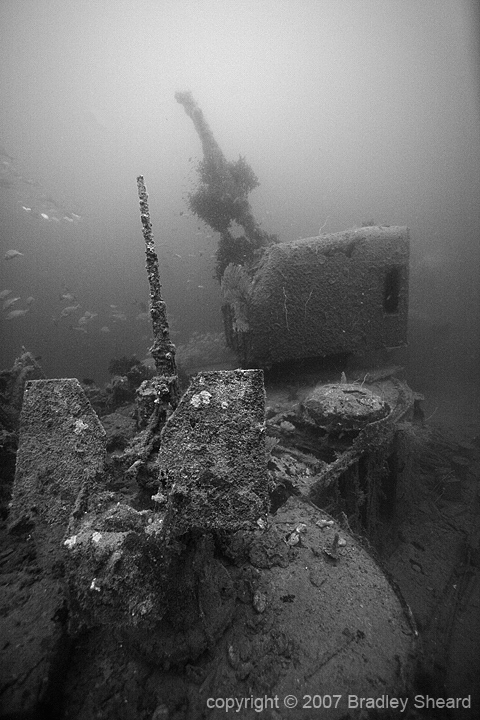 |
| Looking down at the Aaron Ward's foredeck from her bridge. |
Six divers broke out of a clear-blue sky and dropped silently into the depths of Iron Bottom Sound. Unseen and unheard, they descended straight for the USS Aaron Ward some 230 feet below. As the wreck came into view, they were greeted by two five-inch gun turrets--each barrel still elevated and pointed skyward, frozen in their final firing position from a time of deadly conflict some sixty-five years earlier.
Although I had read nearly every account of the Guadalcanal campaign I could find before coming to this sacred place, I felt unprepared for the sight that greeted my eyes. My heart pounded in my chest throughout my first dive to the wreck, where we explored a pair of five-inch gun turrets standing before the towering remains of the ship�s bridge. But the turrets here were not those of a ship sitting in port, neatly aligned along the ship�s axis, but those of a combatant who fought gamely until the end. Each turret is turned in a different direction, and the guns are at different elevations, as if still pursuing two separate dive bombers bent upon the ship�s destruction. This was clearly a battlefield where men fought for their very lives.
The ghostly image of those guns pointing skyward, still locked in place as they were during her final battle, was such a stunning image that it now seems permanently burned into my conscious mind; all I can think of is returning to see her once again.
The Struggle for Guadalcanal
What would become one of the bloodiest campaigns in the Pacific war had its roots in the Allied discovery, in July of 1942, that the Japanese were building an airfield on the island of Guadalcanal in the Solomon Island chain. If allowed to become operational, this air base would endanger the supply and communication routes between the US and Australia, threaten American bases at Espiritu Santo and Efate and allow further Japanese expansion into the Pacific. The Japanese effort on Guadalcanal was perceived as so threatening to the Pacific campaign that a massive amphibious assault on the island was mounted only 1 month after the discovery of the air base.
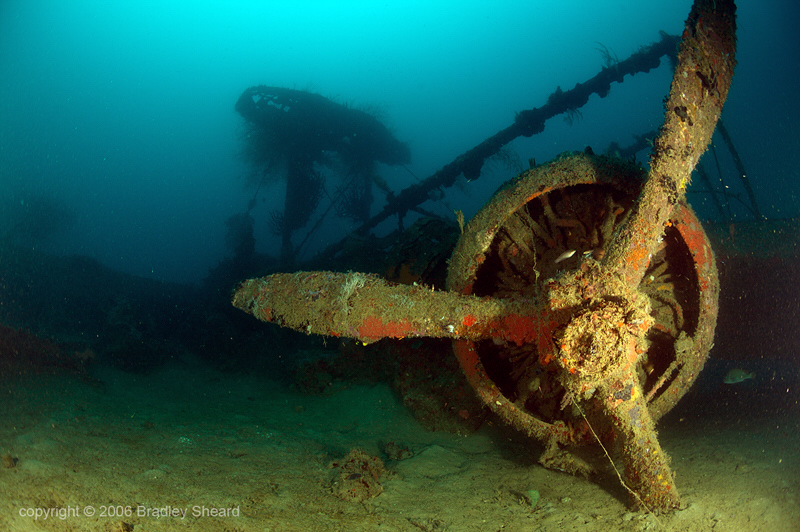 |
| Seven Kawanishi �Mavis� seaplanes were sunk during the invasion of Tulagi. Today, they make fascinating dive sites in relatively shallow water. |
"Operation Watchtower," the first American amphibious operation of the war, caught the Japanese by surprise as 23 transports landed 19,000 marines on Guadalcanal and Tulagi on August 7, 1942. The operation was supported by three aircraft carriers and a small fleet of cruisers and destroyers. The marines quickly seized the partially completed airfield near Lunga Point on Guadalcanal island, but met strong resistance on Tulagi. While caught flat-footed, the Japanese rapidly launched an aerial counterattack with land-based planes from Rabaul that was largely blunted by planes from the three American carriers, although the transport George F Elliott was lost in the action off Tulagi.
Nearly simultaneously with their aerial assault, the Japanese embarked a strong naval force of seven cruisers and one destroyer from their base at Rabaul. Arriving in the dead of night on August 9 in what would soon become known as "Iron Bottom Sound," the Japanese force achieved complete surprise, virtually annihilating the American naval force present. The Japanese would prove superior in night naval engagements throughout the coming campaign, and in the "Battle of Savo Island" they achieved one of the greatest one-sided victories of the war, sinking the three American cruisers Astoria, Vincennes and Quincy, as well as damaging the Australian cruiser Canberra so badly that she was scuttled the following day.
Fearful of more aerial attacks, the three US carriers supporting the amphibious landings withdrew, quickly followed by the remainder of the American naval forces. With no covering warships, the transports had no choice but to also withdraw before completely unloading their supplies. Left behind on the monsoon-soaked islands, with only a 37-day supply of food and short on ammunition, were the US marines--their mission: defend themselves and complete an airfield.
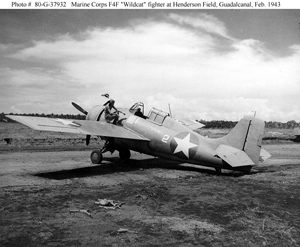 |
| Grumman Wildcat at Henderson Field. |
And complete an airfield is just what these men did. Using ground cleared by the former occupants, abandoned construction gear and the few supplies that had been landed before the transports withdrew, the Seabees had an airfield ready for flight operations only ten days after the invasion began. Named Henderson Field after a Marine hero from the "Battle of Midway," the first planes arrived on August 20 when the escort carrier Long Island delivered 31 Marine Corps fighters--the basis of what would become known as the "Cactus Air force."
Having established control of the seas with their success in the Savo Island action, the Japanese began landing troops and supplies at the western end of Guadalcanal in preparation for retaking the airfield. Once Henderson Field became operational, however, the Americans controlled the skies, and the island became the focus of a fierce contest in which the Americans ruled the daylight hours via air power, while the Japanese commanded the seas during the dark of night. American troops and supplies were brought in during daylight under cover of the Cactus Air Force, while the Japanese sent in supplies with fast transports and destroyers under cover of darkness--a supply operation the Americans nicknamed the "Tokyo Express."
While the Japanese and American soldiers on Guadalcanal ground out a bitter and bloody struggle over Henderson Field and its periphery, their naval counterparts battled over control of Iron Bottom Sound. Near the end of August, in the "Battle of the Eastern Solomons," the few carriers that were still afloat after the Midway and Coral Sea engagements clashed; the Japanese lost the light carrier Ryujo while damaging the Enterprise on the 24th. The following day the Japanese transport Kinryu Maru was sunk by planes out of Henderson. Three days later planes from Enterprise teamed up with the Cactus Air Force to sink the destroyer Asagiri and damage two others north of Guadalcanal. The month was rounded out with Japanese aircraft sinking the high-speed transport Colhoun off Lunga Point with the loss of 51 men on August 30.
September opened where August had left off, with a Japanese destroyer force sinking the high-speed transports Gregory and Little off Lunga Point in a short but fierce gun battle. The US carrier Wasp and battleship North Carolina were torpedoed at mid-month by Japanese submarines; the Wasp was so badly damage that she was abandoned and scuttled. On the ground, mid-September was marked by the famous three-day "Battle of Bloody Ridge," in which American marines successfully repulsed repeated attempts by the Japanese to retake Henderson Field; more than 600 Japanese and 40 US Marines were killed in the confrontation.
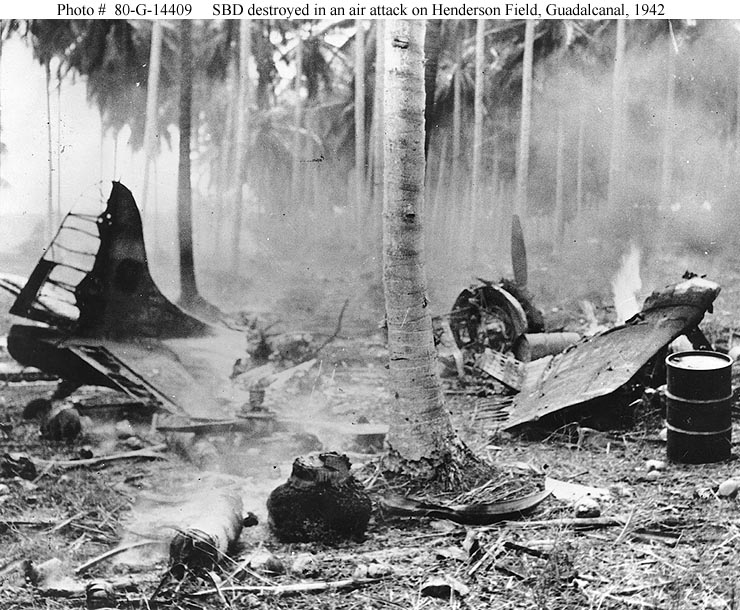 |
| Wrecked planes at Henderson Field after a Japanese bombardment. |
In the second week of October the "Battle of Cape Esperance" added five more ships to the depths of Iron Bottom Sound. This time the Americans managed to best their opponents in a night action with the help of radar--an advantage the Japanese did not have. Rear-Admiral Scott, in command of four cruisers and five destroyers, executed the classic naval maneuver of "crossing the tee" of his opponents force of three cruisers and two destroyers. Able to concentrate his command�s full strength on the Japanese ships from a superior position, Scott�s ships sank a Japanese cruiser and three destroyers while losing a single destroyer.
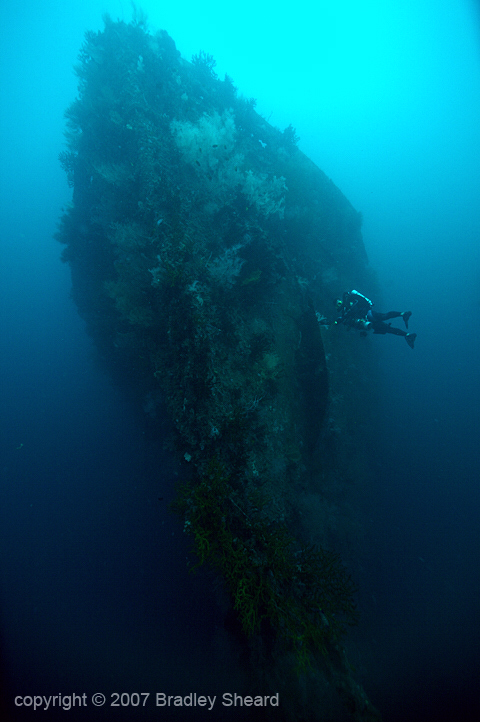 |
| The bow of the transport Azumasan Maru towers over the bottom of Iron Bottom Sound, just off the beach of Guadalcanal. |
The Japanese control of the seas at night led to a series of punishing bombardments of Henderson Field. Beginning on the night of October 14, the battleships Kongo and Haruna pumped more than 900 14-inch shells into the airfield; the next morning only 42 out of 90 planes were still operational. The following night the bombardment continued as the cruisers Chokai and Kinugasa fired 752 8-inch shells, followed by 1500 8-inch shells the next night, delivered by the cruisers Myoko and Maya. Despite the severe damage suffered in the first nights shelling, the Marines ashore at Henderson managed to scrape together enough gasoline to get the few operational planes aloft and found six Japanese transports off Tassafaronga unloading troops and supplies. Exploiting their control of the air, the Cactus Air Force conducted bombing and strafing runs all day, causing the three transports Azumasan Maru, Kyushu Maru and Sasako Maru to beach themselves, becoming total losses, while the other three transports were forced to withdraw. Admiral Nimitz had no choice but to conclude: "It now appears that we are unable to control the sea in the Guadalcanal area. Thus our supply of the positions will only be done at great expense to us. The situation is not hopeless, but it is certainly critical."
The mid-October naval bombardment was merely a softening-up operation, however, for a powerful land offensive intended to retake the island�s airstrip. The Japanese commanders continued to underestimate the strength of the American forces holding Henderson, however, and their repeated thrusts were turned back time and time again. Henderson Field remained in the hands of the American Marines, and the Cactus Air Force continued to control the skies over Guadalcanal.
October closed out with yet another carrier battle to the East, pitting four Japanese carriers against two American in the "Battle of the Santa Cruz Islands." The Japanese managed to sink the USS Hornet and a destroyer, while several of their own carriers were damaged.
The Naval Battle of Guadalcanal
In November the carnage of ships and men in the waters surrounding Guadalcanal reached a crescendo with the three-day "Naval Battle of Guadalcanal." Both sides in the conflict had become frustrated by their respective inability to achieve victory, and both made nearly simultaneous plans to mount major operations. The Japanese sent a major supply mission of 11 high-speed transports "down the Slot," along with a battleship group, to once again bombard Henderson Field. The Allies stepped up their own supply runs for the Marines on Guadalcanal and sent a force to intercept the Japanese fleet; the two forces met South of Savo Island on the night of November 12th.
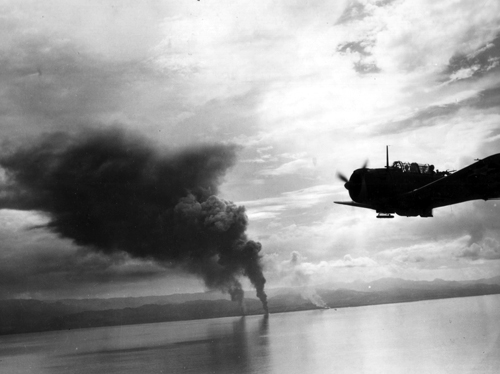 |
| Beached Japanese transports burning on Guadalcanal during the Second Battle of the Solomons, on November 16, 1942. |
The action that ensued was a confused and intermingled melee of ships, men and explosives. The US antiaircraft cruiser Atlanta suffered an early hit by a Japanese torpedo, leaving her crippled and forced out of the action. The destroyer Aaron Ward took nine shell hits and was left dead in the water, while the destroyer Monssen exploded and was abandoned after taking 37 hits. Meanwhile, the Japanese battleship Hiei absorbed more than 50 American shells while the destroyer Akatsuki was sunk by Atlanta.
When morning broke over the still surface of Iron Bottom Sound, eight crippled warships dotted the surface of the sea: Atlanta, Aaron Ward, Portland, Cushing and Monssen on the American side, and Hiei, Yudachi and Yukikaze on the Japanese side. Antagonists to the end, the disabled ships began firing on one another despite their inability to maneuver. Portland managed to throw enough shells into the already abandoned and burning Yudachi that she exploded and disappeared. The American cruiser then managed to make it into Tulagi under her own power, though with much assistance from small craft to help her steer. Atlanta and Aaron Ward were taken under tow, but the crew were unable to keep the cruiser afloat and Atlanta was scuttled; Aaron Ward made it to the anchorage at Tulagi--she would live to fight and die another day. Cushing and Monssen were both hopelessly on fire and slipped beneath the surface later in the day. Hiei was finished off by planes from the carrier Enterprise, Henderson and B-17s out of Espiritu Santo. In this struggle to the death there was no rest for the battle weary, however, and later that morning the antiaircraft cruiser Juneau was hit by a torpedo from the Japanese submarine I-26 while attempting to retire from the area. Juneau, although damaged during the night action, had survived to see morning only to be vaporized by the Japanese torpedo. On board were the five Sullivan brothers, all serving on the same ship, and all sharing a common fate.
The American side had lost more ships and men than their Japanese counterparts, but the Americans could lay claim to having stopped the bombardment of the precious airfield--at least that night. The Japanese were still determined to retake the island, however, and dispatched a new bombardment force on the 13th consisting of 6 cruisers and a like number of destroyers; in addition, a supply run of 11 destroyers and 11 transports was sent down the "Slot" to reinforce the troops ashore. That night they renewed the shelling of the airfield, but when morning came, despite the loss of another 18 planes and damage to 32 more, the airfield was still operational.
On the 14th, planes from Enterprise made repeated attacks on two of the retreating Japanese cruisers and managed to sink the Kinugasa. Meanwhile, reconnaissance flights found the Japanese transport force. This time planes from Enterprise, Henderson and Espiritu Santo combined their efforts to send seven of the transports to the bottom. But Admiral Tanaka was determined to get the supply run through to Guadalcanal and transferred troops from the damaged transports to his destroyers, continuing down the "Slot" with 11 destroyers and the four remaining transports. That night the battle between the two side's capital ships resumed as four Japanese cruisers and destroyers, intent on shelling Henderson Field, were met by Admiral Lee�s force of two battleships and four destroyers in the waters around Savo Island. In another savage night action all four American destroyers were put out of action by Japanese guns while the battleship South Dakota fell under the simultaneous fire of three heavy ships at once. Badly damaged, South Dakota managed to withdraw under cover of the battleship Washington, which herself put the cruiser Kirishima out of action with heavy shell hits, forcing the Japanese to abandon and scuttle her. While the shelling of Henderson Field was once again foiled, and the Japanese capital ships withdrew, "tenacious Tanaka" continued his drive to resupply the troops on Guadalcanal. Finally reaching the Northwest coast of the island on the night of 14-15 November, Tanaka drove the four remaining transports, Yamatsuki Maru, Kinugawa Maru, Hirokawa Maru and Yamaura Maru, onto the beach at Tassafaronga to facilitate a quick unloading before the expected daylight arrival of the now familiar Cactus Air Force. The Japanese were not disappointed in their expectations--that morning the four transports were discovered and the planes out of Henderson spent the day bombing and strafing the ships until they were a total loss.
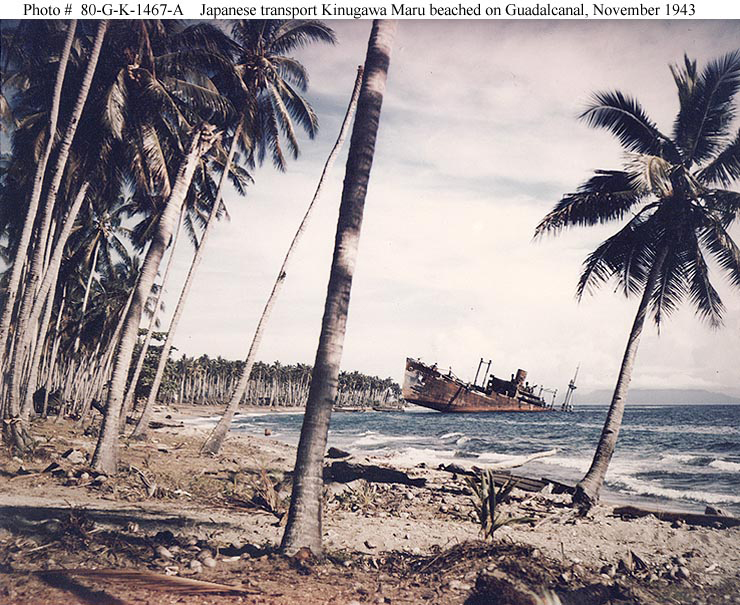 | 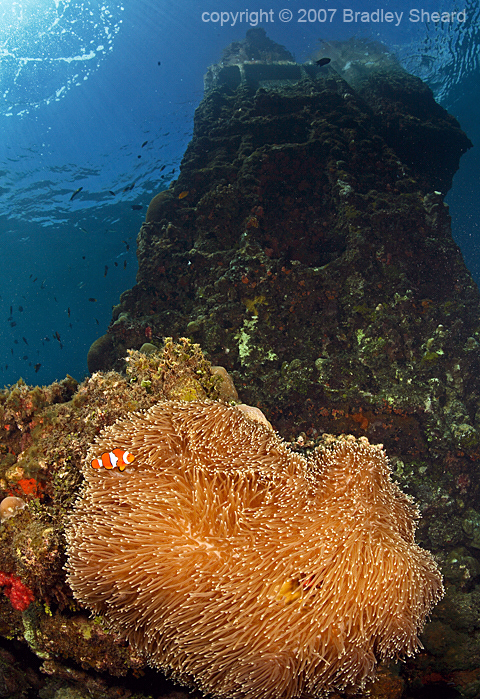 | 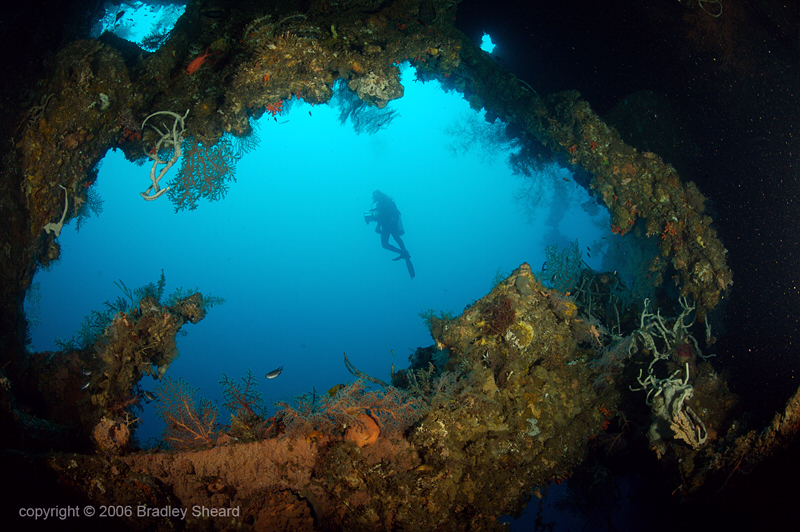 |
| Japanese transport Kinugawa Maru on the beach. | Looking up at the engine of the Kinugawa Maru today. | Looking out from one of the Hirokawa Maru's cargo holds, just off the beach. |
Two weeks later a Japanese supply run of eight destroyers tried a new tactic--dumping supplies loaded into drums off the beach at Tassafaronga, to be recovered by the Army ashore. But the Japanese force was met by Admiral Wright, commanding six destroyers and five cruisers, off Tassafaronga. While the Americans sank the destroyer Takanami, the Japanese sent the cruiser Northampton to the bottom and blew the bow off the cruiser New Orleans, as well as damaging the cruisers Minneapolis and Pensacola.
Two months after the "Battle of Tassafaronga," the Japanese were finally forced to accept the inevitable--their bid to regain the island of Guadalcanal and it�s vital airfield had failed. Over the course of nine days at the beginning of February 1943, using destroyer runs down the "Slot" at night, the Japanese secretly evacuated 11,706 men from Guadalcanal, leaving the Americans in sole possession of the island.
One month later came Admiral Yamamoto�s "I" Operation, a massive aerial assault intended to destroy by air power what they were unable to retake by naval and ground forces. Although the attackers managed to sink the Aaron Ward, Kanawah and Moa, as well as inflict damage to other shipping, this last desperate operation did nothing to blunt the effectiveness of the Allied control of Guadalcanal.
Diving the Wrecks of Iron Bottom Sound
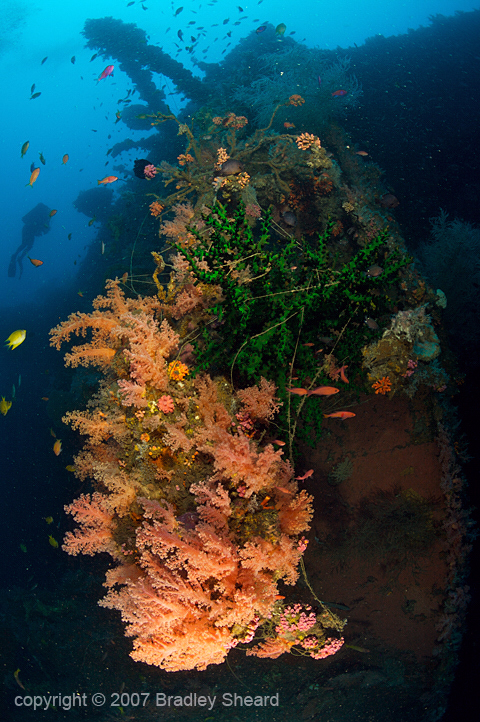 |
| The USS John Penn is teeming with marine life. |
Most of the 50+ wrecks in Iron Bottom Sound are far too deep for scuba diving and lie in the realm of submersibles; there are a few, however, that can be visited by divers. Two Japanese transports lie with their bows nearly on the beach of Guadalcanal Island, where they were beached during the three-day "Naval Battle of Guadalcanal." The Kinugawa Maru�s engine block actually breaks the surface, while her stern rests in 85 feet of water. The remains of her hull just aft of the engine room presents a beautiful, cathedral-like seascape, with shafts of sunlight stabbing through a skeletal rib structure draped in soft corals. The nearby Hirokawa Maru is slightly deeper, as well as being larger and more intact. Her bow lies just beneath the sea�s surface with the stern hitting bottom at 190 feet. Both wrecks can be dived at any depth, or even enjoyed by snorkelers. Further off the Guadalcanal beach lie two more Japanese transports. The Azumasan Maru sits nearly upright, with a slight list to starboard on a steep slope: her bow sits at 160 feet while the stern is in 260 feet or more. Inside the second cargo hold are several motorcycles with sidecars that never made it to Guadalcanal, while a small gun stands on her bow, now made into a work-of-art by colorful corals. Looking up at the ship�s bow from the sand is a stunning sight: the stately bow towers overhead while the anchor chain, dripping in color, takes a shapely curve down toward the sand. The Sasako Maru lies nearby, but is even deeper and requires trimix to explore.
Also on the Guadalcanal side of the Sound is the US transport John Penn. Sunk by aerial attack six months after the Japanese abandoned Guadalcanal, the Penn lies on her starboard side in 185 feet of water. Strong currents often sweep over the site, supporting a rich variety of marine fauna including gorgeous soft corals and lots of pelagic fish. Nearby lies the light cruiser USS Atlanta, but her 400+ foot depth precludes diving by most.
On the Tulagi side of Iron Bottom Sound lie more wrecks, including the crown jewel of diving in these waters, the USS Aaron Ward. The American attack on August 7, 1942, began with Grumman Wildcats from the USS Wasp strafing and sinking seven Kawanishi "Mavis" seaplanes along with eight Nakajima "Rufes" float Zeros, moored in Tulagi Harbor. While the float Zeros were apparently salvaged for intelligence purposes, at least four of the four-engine "Mavis" seaplanes remain and make excellent dives and give plenty of bottom time, lying in only 75-110 feet of water.
Near the back of Tulagi Harbor rests the New Zealand corvette Moa. Largely intact and listing 15-degrees to port in 135 feet of water, the visibility here varies due to a silty bottom. The wreck is fascinating, however, and complete with a 4-inch deck gun on her bow and depth charge racks on the stern; in between are plenty of places to explore. Tucked in the back of the harbor, nearly underneath a local pier in only 50 feet of water, lies the bow section of the heavy cruiser USS Minneapolis. A veteran of the "Battle of Tassafaronga," her bow was nearly blown off by Japanese torpedoes but she managed to limp back to Tulagi, where American sailors finished severing her bow and built a temporary one from coconut logs. The bow now lies upside-down and is surrounded by debris, including a large assortment of cordite and naval shells emptied from her magazine, making for a good rummage dive. An hours ride to the west, in the Buena Vista Islands, lies the Japanese mine sweeper Tama Maru. Sunk by US carrier planes on May 4, 1942, during the opening moves of the "Battle of the Coral Sea," the wreck is listing to port in 250 feet of fantastically clear water.
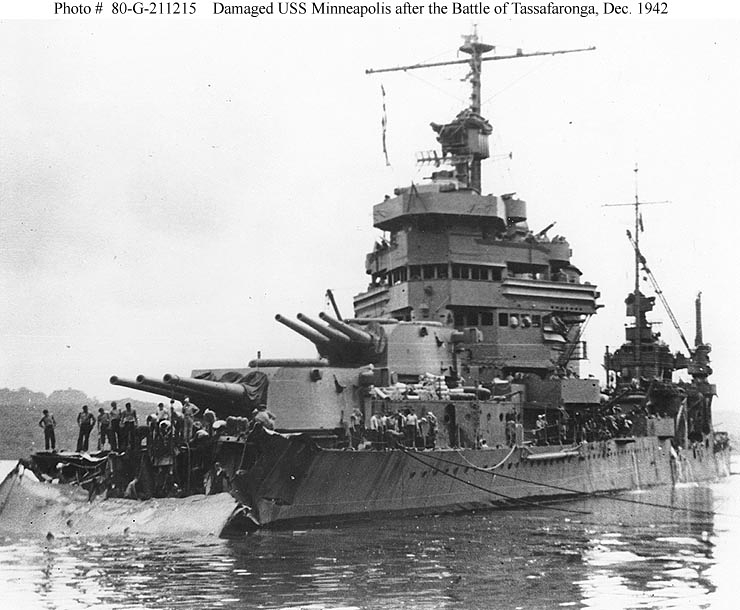 | 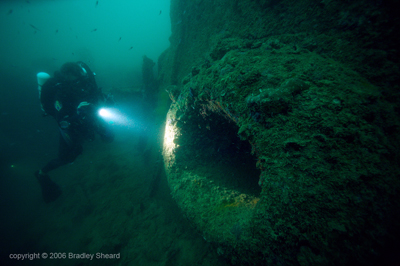 | 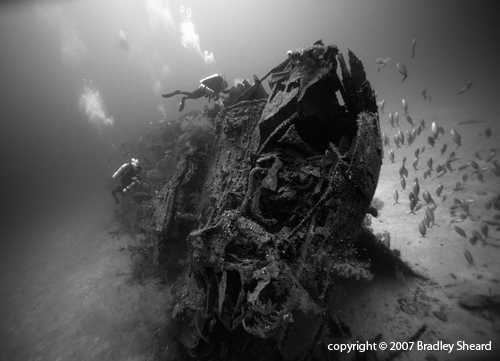 |
| USS Minneapolis, minus her bow, after the "Battle of Tassafaronga." | The Minneapolis' bow now rests upside down at the back of Tulagi Harbor. | The wreck of the Tama Maru is blessed with incredible visibility. |
Near the mouth of Tulagi Harbor sits the fleet oiler USS Kanawha. This magnificent ship stands upright on a 180+ foot bottom, but divers can land on the bow at 140 feet and a bit deeper in the stern. Although she was not a combatant ship, she has no shortage of armament and there seem to be guns everywhere. The bow sports a partially collapsed gun tub with the gun in place minus its barrel; on either side stand 20 mm antiaircraft guns. At the stern is another gun tub with a 3-inch gun; strewn around the tub�s interior are empty shell casings from her last battle against the Japanese aircraft that sank her. On either side stand two enormous naval guns that somehow seem out of place. Midships, divers can find her partially collapsed superstructure, as well as a skylight leading into the engine room, and still more guns.
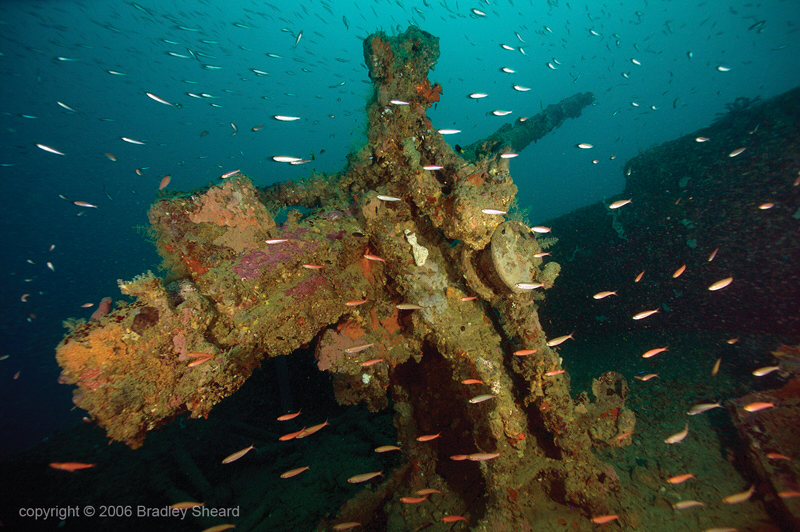 | 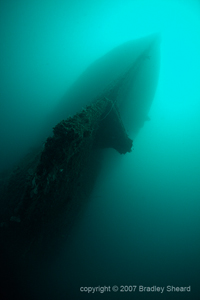 | 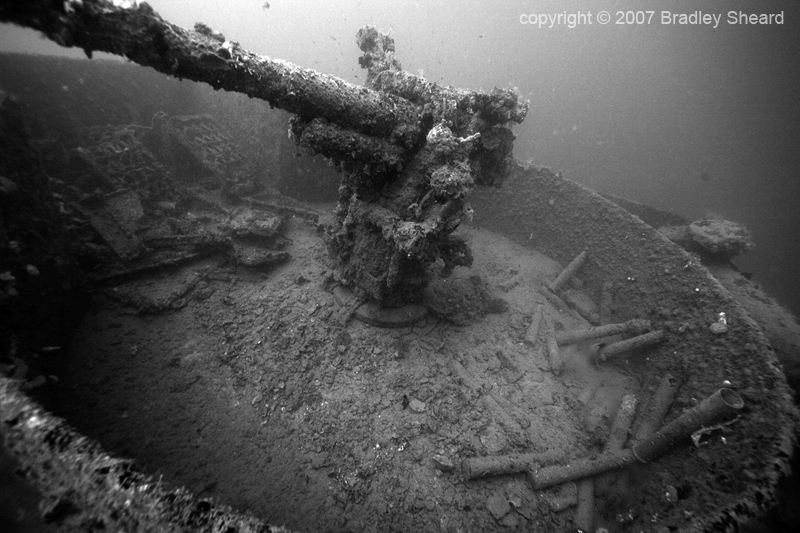 |
| USS Kanawha is covered with guns from stem to stern. | Looking up at the Kanawha's bow from near the 180-foot bottom. | A gun tub on Kanawha's stern is still littered with shell casings expended during the aerial attack that sank her. |
If you are a fan of naval guns, the USS Aaron Ward is definitely for you. This 341-foot destroyer sits upright in 230 feet of water, guns still at action stations and pointing skyward as if locked in battle with the Japanese aircraft that destroyed her 65 years ago. The wreck is visually magnificent, with two five-inch gun turrets both forward and aft, as well as 20 mm and 40 mm antiaircraft guns. Midships a brace of five torpedo tubes lie beneath a towering bridge structure. Her decks seem to be covered in debris, including empty shell casings, and the entire ship gives the appearance of still being in battle. The sight of those gun turrets, eternally frozen in time 65-years ago, is one not easily forgotten. The Ward surely ranks as one of the best wreck dives anywhere--she is that impressive.
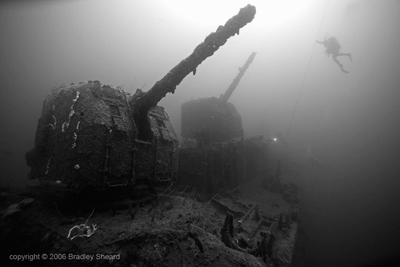 | 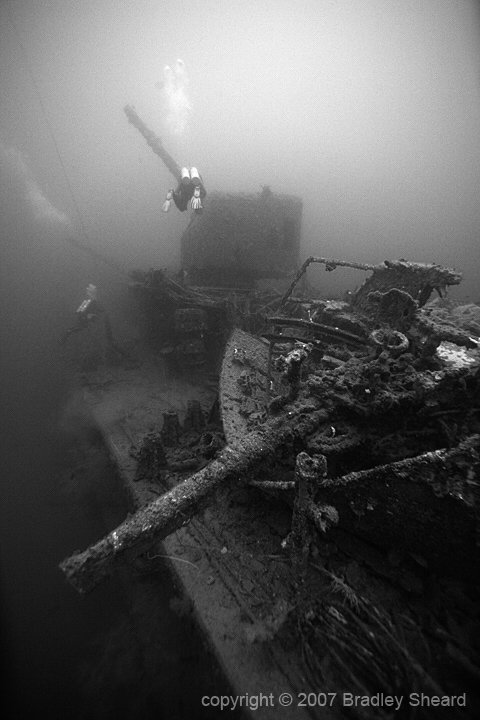 | 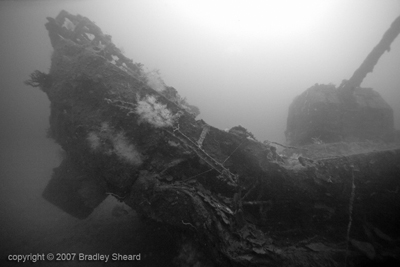 |
| Two five-inch guns still point skyward on the Aaron Ward's stern, as if poised for battle. | 40mm antiaircraft gun and 5-inch turret on the Aaron Ward's stern. | Aaron Ward's stern is bent upward as a result of impacting the bottom when she sank. |
Tthe best option for diving the deeper wrecks off both Guadalcanal and Tulagi is Neil Yates� Tulagi Dive operation, located on Tulagi Island in the Florida group. tulagidive.com.sb Neil first came here on holiday, dived "the Ward," met his girlfriend Yolande Jordaan, and returned to buy the business and build it into what is surely one of the top "technical" dive shops in the Pacific region. Extremely knowledgeable about both the history of the region and the wrecks, his operation is superbly equipped for this type of deep diving. With a large variety of cylinder sizes ranging from small pony tanks, various stage bottles and single tanks or isolation-manifolded twins, most diving is done using air as a bottom mix with 50% and 100% nitrox mixes for decompression. (Helium is available at a significant cost and several months lead time.) Neil�s is the best dive operation I�ve seen anywhere in the Pacific, and would put many shops in the United States to shame.
Diving is done from a 7-meter aluminum boat with dual outboards. It is extremely stable and well setup for technical diving and can accommodate up to ten divers with double tanks and stage bottles. Neil has permanent moorings on most of the wrecks, and those on the Tulagi side are literally minutes from the dive shop--the Aaron Ward is only 11 minutes from dock to wreck! The boat is equipped with a breakaway floating decompression station that can be detached from both the boat and the permanent mooring when currents dictate.
Accommodations at the attached Vanita Lodge are simple dormitory style with common toilet facilities. Electricity is 230 volt Australian style plugs. The weather is generally hot and often humid, and while there are ceiling fans in the rooms there is no air conditioning. Food consists largely of local rice dishes served buffet style in the open-air lounge and dining room. Neil and Yolande are currently making final plans to build a new resort and move the dive operation to nearby historic Gavutu Island--keep your eye on their website for the latest news!
